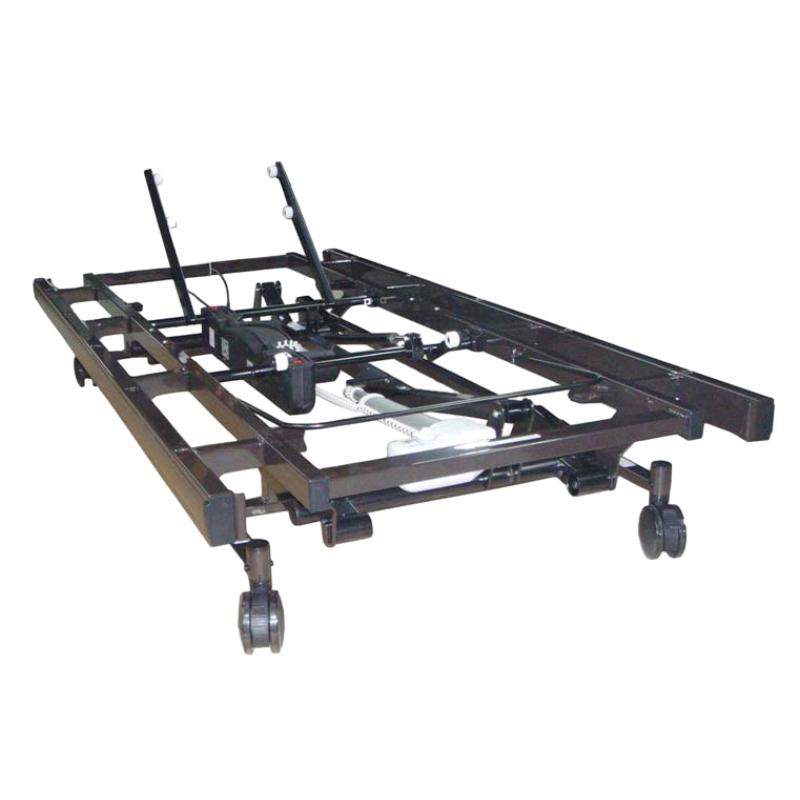What is the difference between medical bed and regular bed? Medical
Apr . 22, 2024 10:58
If you’re looking for a bed for a sick loved one, you might have thought that a regular bed might not cut it. Beds are more than just furniture that we use for sleeping, especially for people with medical conditions. Beds are necessary to recuperate and if a sick person is not getting the rest they need, it might take time for them to heal, or worse, their condition might be aggravated.

Design and development
Regular beds are beds that we typically see in every home, hotels, dorms and other lodging place. Design and development for regular beds are nothing special as long as there is a sturdy bed frame, headboard and in some types with handrails. Regular beds are usually made out of wood, metal or a combination of both. These beds are designed and developed with comfort in mind.
If regular beds were designed and developed for comfort, hospital beds on the other hand were specifically made for support. These beds are for those with health conditions and mobility limitations. These beds are also customizable to meet the requirements of the user and to make it easier for caregivers to provide care and support. These beds come with safety features like brakes, and side rails to prevent the patient from falling.
Portability
Conventional beds are immobile. Yes, they can be moved but it usually entails having to ask someone to help lift the bed. In some cases, regular beds even have to be disassembled to make moving them easier.
One of the most distinct differences between a regular bed and a medical bed is its portability. These beds have wheels or casters to make moving it inside homes or healthcare facilities effortlessly. With its mobility, it’s easier to move patients around to a different room, to an operating room or to transfer to an ambulance if necessary.

Mattress
Mattresses used on regular beds are comfortable enough for sleeping daily. However, they are not suitable for those with medical disorders especially those who have chronic pain, breathing problems or pressure ulcers. Even if the mattresses used for regular beds are firm, these are just to accommodate sleepers who prefer to sleep on solid beds rather than to accommodate medical needs.
Hospital beds come with special mattresses that help ease pressure points, lower chances of bedsores, and spinal alignment. These special mattresses have air-filled chambers and foam that meet the comfort preferences and medical requirements of the user, especially those that need extended bed rest.
Accessibility features
There are no accessibility features for regular beds.
Another major difference between the two is accessibility features. Since people with restricted mobility may find it difficult to get in and out of bed, regular beds that do not have any accessibility features will not be suitable. Hospital or patient beds on the other hand have the following accessibility features:
- Grab bars
- Side rails
- Height adjusting mechanisms
- Assistive equipment
These accessibility features make it easier for caregivers to provide care for patients and to lower the risk of falls or injuries.
Key takeaway
It’s easy to decide whether what you need is a regular or a special bed for a patient since the differences between the two are obvious, depending on the purpose. If you are after style and overall comfort, regular beds will do. But if the bed needs to meet the specific needs of users with limited mobility or with health conditions, medical beds are the answer.

FAQs
Can you use a regular mattress on a medical bed?
No. Special mattresses are needed on these patient beds since regular mattresses are inflexible and will not be able to accommodate the different positions a medical bed can take.
What is the purpose of the medical bed?
The purpose of this type of bed is to provide support to patients with medical conditions or users who are on extended bed rest. The patient bed is also portable and has accessibility features to make it easier for caregivers.
What is another name for a medical bed?
Patient bed is another name for a medical bed.
Can a normal person sleep on a medical bed?
Yes. There are numerous advantages to sleeping on this type of bed designed for patients even if someone is well or able bodied. These benefits include better posture and reduced back pain which could lead to better and improved sleep.
 Afrikaans
Afrikaans  Albanian
Albanian  Amharic
Amharic  Arabic
Arabic  Armenian
Armenian  Azerbaijani
Azerbaijani  Basque
Basque  Belarusian
Belarusian  Bengali
Bengali  Bosnian
Bosnian  Bulgarian
Bulgarian  Catalan
Catalan  Cebuano
Cebuano  Corsican
Corsican  Croatian
Croatian  Czech
Czech  Danish
Danish  Dutch
Dutch  English
English  Esperanto
Esperanto  Estonian
Estonian  Finnish
Finnish  French
French  Frisian
Frisian  Galician
Galician  Georgian
Georgian  German
German  Greek
Greek  Gujarati
Gujarati  Haitian Creole
Haitian Creole  hausa
hausa  hawaiian
hawaiian  Hebrew
Hebrew  Hindi
Hindi  Miao
Miao  Hungarian
Hungarian  Icelandic
Icelandic  igbo
igbo  Indonesian
Indonesian  irish
irish  Italian
Italian  Japanese
Japanese  Javanese
Javanese  Kannada
Kannada  kazakh
kazakh  Khmer
Khmer  Rwandese
Rwandese  Korean
Korean  Kurdish
Kurdish  Kyrgyz
Kyrgyz  Lao
Lao  Latin
Latin  Latvian
Latvian  Lithuanian
Lithuanian  Luxembourgish
Luxembourgish  Macedonian
Macedonian  Malgashi
Malgashi  Malay
Malay  Malayalam
Malayalam  Maltese
Maltese  Maori
Maori  Marathi
Marathi  Mongolian
Mongolian  Myanmar
Myanmar  Nepali
Nepali  Norwegian
Norwegian  Norwegian
Norwegian  Occitan
Occitan  Pashto
Pashto  Persian
Persian  Polish
Polish  Portuguese
Portuguese  Punjabi
Punjabi  Romanian
Romanian  Samoan
Samoan  Scottish Gaelic
Scottish Gaelic  Serbian
Serbian  Sesotho
Sesotho  Shona
Shona  Sindhi
Sindhi  Sinhala
Sinhala  Slovak
Slovak  Slovenian
Slovenian  Somali
Somali  Spanish
Spanish  Sundanese
Sundanese  Swahili
Swahili  Swedish
Swedish  Tagalog
Tagalog  Tajik
Tajik  Tamil
Tamil  Tatar
Tatar  Telugu
Telugu  Thai
Thai  Turkish
Turkish  Turkmen
Turkmen  Ukrainian
Ukrainian  Urdu
Urdu  Uighur
Uighur  Uzbek
Uzbek  Vietnamese
Vietnamese  Welsh
Welsh  Bantu
Bantu  Yiddish
Yiddish  Yoruba
Yoruba  Zulu
Zulu 














